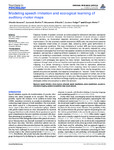Modeling speech imitation and ecological learning of auditory-motor maps.
| dc.contributor.author | Canevari, C | en |
| dc.contributor.author | Badino, L | en |
| dc.contributor.author | D'Ausilio, A | en |
| dc.contributor.author | Fadiga, L | en |
| dc.contributor.author | Metta, G | en |
| dc.date.accessioned | 2017-06-23T15:47:49Z | |
| dc.date.available | 2017-06-23T15:47:49Z | |
| dc.date.issued | 2013 | en |
| dc.identifier.issn | 1664-1078 | en |
| dc.identifier.uri | http://hdl.handle.net/10026.1/9542 | |
| dc.description.abstract |
Classical models of speech consider an antero-posterior distinction between perceptive and productive functions. However, the selective alteration of neural activity in speech motor centers, via transcranial magnetic stimulation, was shown to affect speech discrimination. On the automatic speech recognition (ASR) side, the recognition systems have classically relied solely on acoustic data, achieving rather good performance in optimal listening conditions. The main limitations of current ASR are mainly evident in the realistic use of such systems. These limitations can be partly reduced by using normalization strategies that minimize inter-speaker variability by either explicitly removing speakers' peculiarities or adapting different speakers to a reference model. In this paper we aim at modeling a motor-based imitation learning mechanism in ASR. We tested the utility of a speaker normalization strategy that uses motor representations of speech and compare it with strategies that ignore the motor domain. Specifically, we first trained a regressor through state-of-the-art machine learning techniques to build an auditory-motor mapping, in a sense mimicking a human learner that tries to reproduce utterances produced by other speakers. This auditory-motor mapping maps the speech acoustics of a speaker into the motor plans of a reference speaker. Since, during recognition, only speech acoustics are available, the mapping is necessary to "recover" motor information. Subsequently, in a phone classification task, we tested the system on either one of the speakers that was used during training or a new one. Results show that in both cases the motor-based speaker normalization strategy slightly but significantly outperforms all other strategies where only acoustics is taken into account. | en |
| dc.format.extent | 364 - ? | en |
| dc.language | eng | en |
| dc.language.iso | eng | en |
| dc.subject | acoustic-to-articulatory mapping | en |
| dc.subject | automatic speech classification | en |
| dc.subject | deep neural networks | en |
| dc.subject | mirror neurons | en |
| dc.subject | phone classification | en |
| dc.subject | speaker normalization | en |
| dc.subject | speech imitation | en |
| dc.title | Modeling speech imitation and ecological learning of auditory-motor maps. | en |
| dc.type | Journal Article | |
| plymouth.author-url | https://www.ncbi.nlm.nih.gov/pubmed/23818883 | en |
| plymouth.volume | 4 | en |
| plymouth.publication-status | Published online | en |
| plymouth.journal | Front Psychol | en |
| dc.identifier.doi | 10.3389/fpsyg.2013.00364 | en |
| plymouth.organisational-group | /Plymouth | |
| plymouth.organisational-group | /Plymouth/Faculty of Science and Engineering | |
| plymouth.organisational-group | /Plymouth/REF 2021 Researchers by UoA | |
| plymouth.organisational-group | /Plymouth/REF 2021 Researchers by UoA/UoA11 Computer Science and Informatics | |
| dc.publisher.place | Switzerland | en |
| dcterms.dateAccepted | 2013-06-04 | en |
| dc.rights.embargoperiod | Not known | en |
| rioxxterms.versionofrecord | 10.3389/fpsyg.2013.00364 | en |
| rioxxterms.licenseref.uri | http://www.rioxx.net/licenses/all-rights-reserved | en |
| rioxxterms.licenseref.startdate | 2013 | en |
| rioxxterms.type | Journal Article/Review | en |


